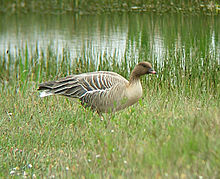Pink-footed geese
| Pink-footed goose | |
|---|---|
 |
|
| Scientific classification | |
| Kingdom: | Animalia |
| Phylum: | Chordata |
| Class: | Aves |
| Order: | Anseriformes |
| Family: | Anatidae |
| Genus: | Anser |
| Species: | A. brachyrhynchus |
| Binomial name | |
|
Anser brachyrhynchus Baillon, 1834 |
|
The pink-footed goose (Anser brachyrhynchus) is a goose which breeds in eastern Greenland, Iceland and Svalbard. It is migratory, wintering in northwest Europe, especially Ireland, Great Britain, the Netherlands, and western Denmark. The name is often abbreviated in colloquial usage to "pinkfoot" (plural "pinkfeet"). Anser is the Latin for "goose", and brachyrhynchus comes from the Greek brakhus "short" and rhunkhos "bill".
It is a medium-sized goose, 60–75 cm (24–30 in) long, the wingspan 135–170 cm (53–67 in), and weighing 1.8–3.4 kg (4.0–7.5 lb). It has a short bill, bright pink in the middle with a black base and tip, and pink feet. The body is mid-grey-brown, the head and neck a richer, darker brown, the rump and vent white, and the tail grey with a broad white tip. The upper wing-coverts are of a somewhat similar pale bluish-grey as in the greylag goose, and the flight feathers blackish-grey. The species is most closely related to the bean goose Anser fabalis (having even been treated as a subspecies of it at times in the past), sharing a similar black-and-coloured pattern bill, but differing in having pink on the bill and legs where the bean goose is orange, and in the paler, greyer plumage tones. It is similar in size to the small rossicus subspecies of bean goose, but distinctly smaller than the nominate subspecies fabalis. It produces a medley of high-pitched honking calls, being particularly vocal in flight, with large skeins being almost deafening.
There are two largely discrete populations of pink-footed goose. The Greenland and Iceland population winter in Great Britain, while the Svalbard population winters in the Netherlands and Denmark, with small numbers also in Norway (where it is common on migration), northern Germany, and Belgium.
Populations have risen spectacularly over the last 50 years, due largely to increased protection from shooting on the wintering grounds. Numbers wintering in Ireland and Great Britain have risen almost tenfold from 30,000 in 1950 to 292,000 in October 2004. The numbers wintering in Denmark and the Netherlands have also risen, with about 34,000 in 1993. The most important single breeding site, at Þjórsárver in Iceland (holding 10,700 pairs in 1970), was only discovered in 1951, by Sir Peter Scott and his team who made an expedition to seek the breeding grounds. Within Great Britain, the most important wintering areas are in Norfolk (147,000 in 2004), Lancashire (44,000 in 2004), and Aberdeenshire (primarily on autumn and spring passage). Large to huge wintering flocks graze on farmland; individual flocks can be spectacular, such as the 66,000 at Loch of Strathbeg, Aberdeenshire in early September 2003.
...
Wikipedia

